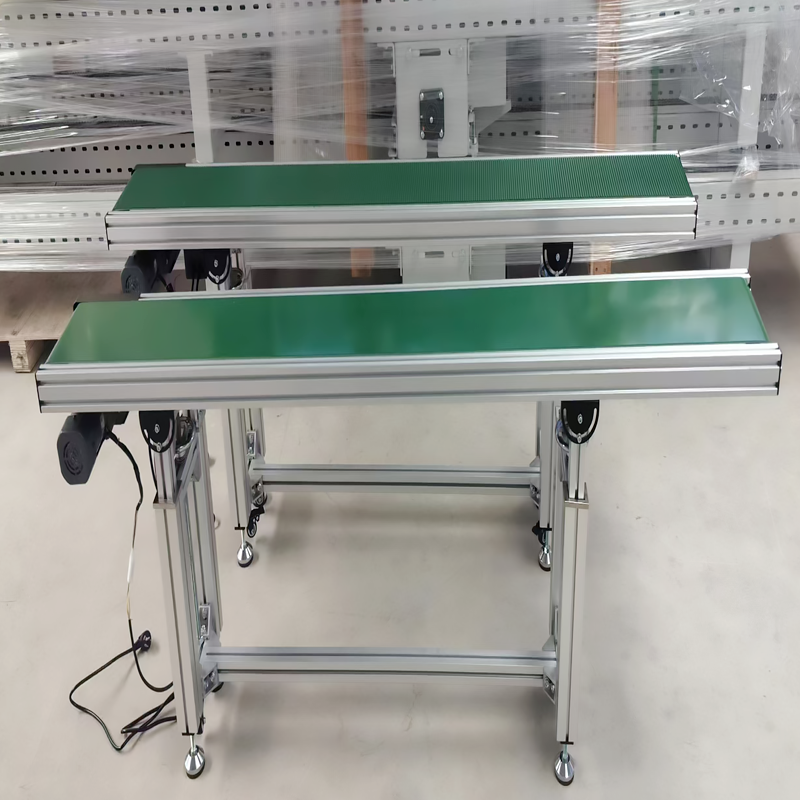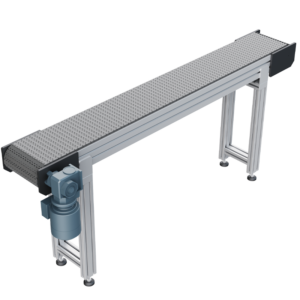Belt conveyors are essential systems designed for efficiently transporting materials across various industries. Belt conveyors consist of a continuous loop of belt that moves items from one point to another, making them ideal for assembly lines, warehouses, and manufacturing facilities.
Description
Toshine Versatile Belt Conveyors for Material Handling
What are Aluminum Belt Convoyeurs?
Aluminum belt conveyors are systems that use aluminum to move materials like gravel, sand, lightweight aggregates, and concrete mixes. Belt conveyors can work in many settings but are not ideal for humid areas or where stainless steel is essential. These belt conveyors come in various types and widths, including flat, elevator, feeder, bunker, bend, vertical curved, and Z conveyors.
Aluminum belt conveyors offer several benefits compared to those made from steel or stainless steel. So belt conveyors are quicker to produce and assemble. En plus, people can use them in many industries, such as food, beverage, produits de beauté, and printing, to help automate the movement of items like bottles, electronic parts, plastic bags, and paper boxes.
Simplified Explanation of Belt Convoyeurs
Belt conveyors lines are the most common type of equipment we use for moving materials. Belt conveyors can be part of other machines or work on their own. Belt conveyors can also connect different machines to create a complete automated production line. Learning how to design belt lines is an essential skill for mechanical engineers.
Belt conveyors, people also know them as belt assembly lines or simply belt conveyors. So belt conveyors work by using a belt to transport items and are cost-effective equipment needed for assembly lines.

Types of Belt Convoyeurs
There are several types of belt conveyors:
- Straight belt conveyors
- Belt conveyor with a workbench
- Climbing belt conveyors
- Turning belt conveyors
- Trough belt conveyors
- Telescopic belt conveyors
- Knife-edge belt conveyors
- Sidewall belt conveyors
- Circular tube belt conveyors (new type)
Basic Parts and How Work
While different belt conveyors may look different, belt conveyors all work on the same principle. Here are the basic parts:
- Conveyor Belt: This is what carries the items or materials. As the belt moves, items slide along it due to the friction between the belt and the items. The upper part of the belt carries the load, while the lower part returns without carrying anything.
- Driving Roller: This roller provides the power to move the belt. It spins because of a motor, and the friction between the roller and the belt makes the belt move.
- Driven Roller: This is a roller that does not provide power. It rotates freely and helps keep the belt tight, working with the driving roller.
- Support Pallet or Roller: This part supports the belt and the materials on it. It prevents the belt from sagging. So users use a flat pallet when they need a smooth surface , while they use rollers in the return section.
Other Basic Parts
- Positioning Baffles: These are barriers on both sides of the belt that keep items in place as they move.
- Tensioning Mechanism: This adjusts the belt’s tightness since the belt may become loose over time. It is also important for installing and removing the belt.
- Frame: People can make the frame of the belt conveyor in different shapes based on what it’s used for. En plus, they can also make it from different materials, such as metal or welded frames.
- Motor Drive System: The motor drives the roller. Usually, the motor is slowed down by a reducer and then connected to the roller by gears, chains, or belts. In some cases, the motor is directly connected to the roller.
- Power Options: The conveyor can have a fixed speed or adjustable speed. En plus, it can also move in one direction or change direction.
For longer belt conveyors lines, multiple systems are usually lined up together at the same height.
Main Technical Specs
- Conveying Forms: These include various workbench styles, such as single-sided or double-sided.
- Driving Form: Typically motor-driven.
- Belt Widths: Common widths range from 20 à 2000 mm, with custom sizes available.
- Belt Materials: These can include rubber, PVC, canvas, or food-grade materials.
- Belt Types: Options include belts with baffles, enclosed belts, flat belts, and anti-slip belts.
- Workbench Size: This depends on the user.
- Surface Options: Work surfaces can be fireproof materials, rubber, or anti-static rubber.
- Frame Materials: Options include stainless steel, aluminum, and carbon steel.
- Conveying Speed: Typically between 0.1 à 10 m/min, users can adjust it as they need.
- Régulation de vitesse: Can include various methods like frequency conversion, electromagnetic control, or mechanical adjustment.
- Matériau à cadre: Can be carbon steel, acier inoxydable, or aluminum.
Dans l'ensemble, belt conveyors are versatile tools that help efficiently move materials in many industries.





